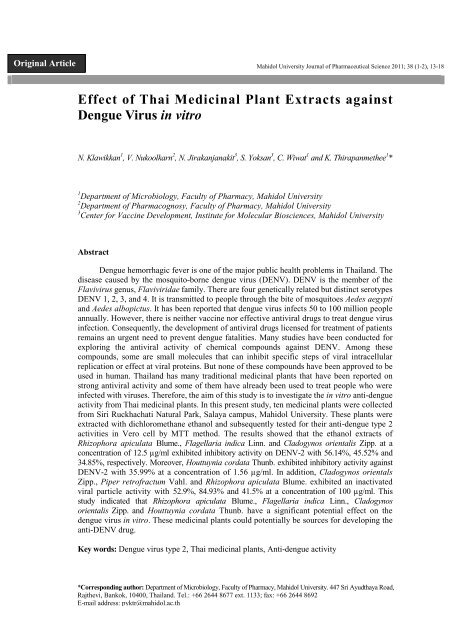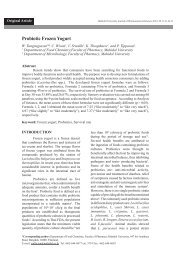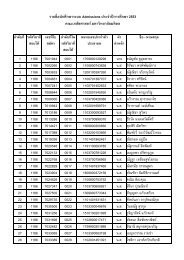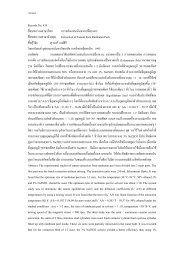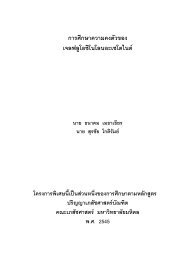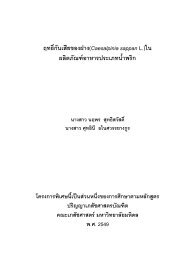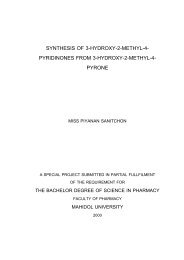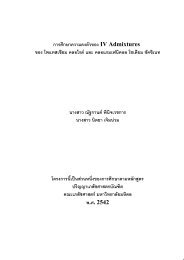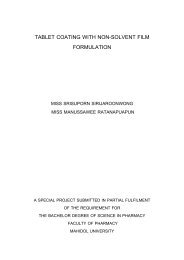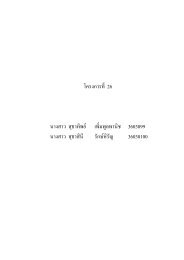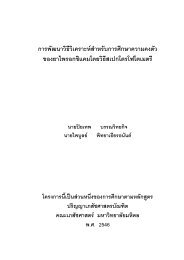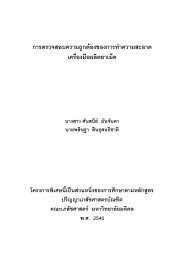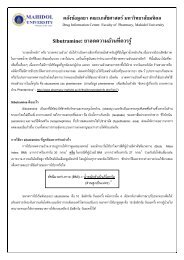Effect of Thai Medicinal Plant Extracts against Dengue Virus in vitro
Effect of Thai Medicinal Plant Extracts against Dengue Virus in vitro
Effect of Thai Medicinal Plant Extracts against Dengue Virus in vitro
You also want an ePaper? Increase the reach of your titles
YUMPU automatically turns print PDFs into web optimized ePapers that Google loves.
Orig<strong>in</strong>al Article Mahidol University Journal <strong>of</strong> Pharmaceutical Science 2011; 38 1-2, 13-18<strong>Effect</strong> <strong>of</strong> <strong>Thai</strong> <strong>Medic<strong>in</strong>al</strong> <strong>Plant</strong> <strong>Extracts</strong> <strong>aga<strong>in</strong>st</strong><strong>Dengue</strong> <strong>Virus</strong> <strong>in</strong> <strong>vitro</strong>N. Klawikkan 1 , V. Nukoolkarn 2 , N. Jirakanjanakit 3 , S. Yoksan 3 , C. Wiwat 1 and K. Thirapanmethee 1 *1 Department <strong>of</strong> Microbiology, Faculty <strong>of</strong> Pharmacy, Mahidol University2 Department <strong>of</strong> Pharmacognosy, Faculty <strong>of</strong> Pharmacy, Mahidol University3 Center for Vacc<strong>in</strong>e Development, Institute for Molecular Biosciences, Mahidol UniversityAbstract<strong>Dengue</strong> hemorrhagic fever is one <strong>of</strong> the major public health problems <strong>in</strong> <strong>Thai</strong>land. Thedisease caused by the mosquito-borne dengue virus (DENV). DENV is the member <strong>of</strong> theFlavivirus genus, Flaviviridae family. There are four genetically related but dist<strong>in</strong>ct serotypesDENV 1, 2, 3, and 4. It is transmitted to people through the bite <strong>of</strong> mosquitoes Aedes aegyptiand Aedes albopictus. It has been reported that dengue virus <strong>in</strong>fects 50 to 100 million peopleannually. However, there is neither vacc<strong>in</strong>e nor effective antiviral drugs to treat dengue virus<strong>in</strong>fection. Consequently, the development <strong>of</strong> antiviral drugs licensed for treatment <strong>of</strong> patientsrema<strong>in</strong>s an urgent need to prevent dengue fatalities. Many studies have been conducted forexplor<strong>in</strong>g the antiviral activity <strong>of</strong> chemical compounds <strong>aga<strong>in</strong>st</strong> DENV. Among thesecompounds, some are small molecules that can <strong>in</strong>hibit specific steps <strong>of</strong> viral <strong>in</strong>tracellularreplication or effect at viral prote<strong>in</strong>s. But none <strong>of</strong> these compounds have been approved to beused <strong>in</strong> human. <strong>Thai</strong>land has many traditional medic<strong>in</strong>al plants that have been reported onstrong antiviral activity and some <strong>of</strong> them have already been used to treat people who were<strong>in</strong>fected with viruses. Therefore, the aim <strong>of</strong> this study is to <strong>in</strong>vestigate the <strong>in</strong> <strong>vitro</strong> anti-dengueactivity from <strong>Thai</strong> medic<strong>in</strong>al plants. In this present study, ten medic<strong>in</strong>al plants were collectedfrom Siri Ruckhachati Natural Park, Salaya campus, Mahidol University. These plants wereextracted with dichloromethane ethanol and subsequently tested for their anti-dengue type 2activities <strong>in</strong> Vero cell by MTT method. The results showed that the ethanol extracts <strong>of</strong>Rhizophora apiculata Blume., Flagellaria <strong>in</strong>dica L<strong>in</strong>n. and Cladogynos orientalis Zipp. at aconcentration <strong>of</strong> 12.5 µg/ml exhibited <strong>in</strong>hibitory activity on DENV-2 with 56.14%, 45.52% and34.85%, respectively. Moreover, Houttuynia cordata Thunb. exhibited <strong>in</strong>hibitory activity <strong>aga<strong>in</strong>st</strong>DENV-2 with 35.99% at a concentration <strong>of</strong> 1.56 µg/ml. In addition, Cladogynos orientalsZipp., Piper retr<strong>of</strong>ractum Vahl. and Rhizophora apiculata Blume. exhibited an <strong>in</strong>activatedviral particle activity with 52.9%, 84.93% and 41.5% at a concentration <strong>of</strong> 100 µg/ml. Thisstudy <strong>in</strong>dicated that Rhizophora apiculata Blume., Flagellaria <strong>in</strong>dica L<strong>in</strong>n., Cladogynosorientalis Zipp. and Houttuynia cordata Thunb. have a significant potential effect on thedengue virus <strong>in</strong> <strong>vitro</strong>. These medic<strong>in</strong>al plants could potentially be sources for develop<strong>in</strong>g theanti-DENV drug.Key words: <strong>Dengue</strong> virus type 2, <strong>Thai</strong> medic<strong>in</strong>al plants, Anti-dengue activity*Correspond<strong>in</strong>g author: Department <strong>of</strong> Microbiology, Faculty <strong>of</strong> Pharmacy, Mahidol University. 447 Sri Ayudthaya Road,Rajthevi, Bankok, 10400, <strong>Thai</strong>land. Tel.: +66 2644 8677 ext. 1133; fax: +66 2644 8692E-mail address: pyktr@mahidol.ac.th
14N. Klawikkan et al.INTRODUCTION<strong>Dengue</strong> hemorrhagic fever is one <strong>of</strong>the most important emerg<strong>in</strong>g tropicaldiseases <strong>in</strong> the 21 st century 1 . In the latterpart <strong>of</strong> the 20 th century, globalization andrapid urbanization <strong>of</strong> many develop<strong>in</strong>gtropical countries produced <strong>in</strong>creasedtransmission and hyperendemicity <strong>of</strong> thedisease 2 . World Health Organization (WHO)estimates that there are as many as 50million cases <strong>of</strong> dengue <strong>in</strong>fection worldwideand global warm<strong>in</strong>g provide a significantselective advantage for dengue <strong>in</strong>fectionspread<strong>in</strong>g <strong>in</strong>to new areas 3 . <strong>Dengue</strong> <strong>in</strong>fectionis caused by dengue virus (DENV). DENVbelongs to the genus Flavivirus <strong>in</strong> thefamily Flaviviridae. There are four dist<strong>in</strong>ctserotypes <strong>of</strong> DENV: 1, 2, 3, and 4. Thevirion conta<strong>in</strong>s a positive-sense, s<strong>in</strong>glestrandedRNA molecule <strong>of</strong> approximately11 kb <strong>in</strong> length, <strong>in</strong>serted <strong>in</strong> an icosahedralnucleocapsid and surrounded by a lipidenvelope-covered with peplomers. The viralgenome is translated <strong>in</strong>to three structuralprote<strong>in</strong>s, capsid (C), pre-membrane (prM),envelope (E) and seven non-structuralprote<strong>in</strong>s (NS1, NS2a, NS2b, NS3, NS4a,NS4b and NS5) 3,4 . DENV is transmittedpr<strong>in</strong>cipally by Aedes aegypti mosquito.Other mosquito such as Ae. albopictusand Ae. polynesiensis can also transmitepidemic dengue, but less efficiently 5 .Cl<strong>in</strong>ical manifestation <strong>of</strong> DENV <strong>in</strong>fectionrange from subcl<strong>in</strong>ical to a self-limitedfever and rash (dengue fever (DF)) to asevere and sometimes deadly illnesscharacterized by capillary leakage,thrombocytopenia and hypovolemic shock(dengue hemorrhagic fever (DHF) anddengue shock syndrome (DSS)) 6 .At present, no specific treatmentsfor DENV <strong>in</strong>fection are cl<strong>in</strong>ically available.Control <strong>of</strong> DENV by safe, low-cost and longlast<strong>in</strong>gvacc<strong>in</strong>ation has not been established.Several types <strong>of</strong> antiviral agent have beensought <strong>in</strong>tensively, <strong>in</strong>clud<strong>in</strong>g <strong>in</strong>hibitors<strong>aga<strong>in</strong>st</strong> viral replication, posttranslationalprocess<strong>in</strong>g <strong>of</strong> viral prote<strong>in</strong>s and E prote<strong>in</strong>functions such as membrane fusion andviral attachment 7 . A number <strong>of</strong> antiviralcompounds, i.e. ribavir<strong>in</strong>, mycophenolicacid, 7-deaza-2’-c-methyl-adenos<strong>in</strong>e and 6-O-butanoyl castanosperm<strong>in</strong>e have showntheir efficacy <strong>in</strong> <strong>in</strong>hibit<strong>in</strong>g DENV replication<strong>in</strong> <strong>vitro</strong> 8 . The only available treatmentis supportive therapy. Therefore, it isnecessary to f<strong>in</strong>d new alternative antiviralcompounds <strong>aga<strong>in</strong>st</strong> DENV 9 . <strong>Plant</strong>s havelong been used as a source <strong>of</strong> medic<strong>in</strong>efrom ancient time to today all over theworld 10 . Many traditional medic<strong>in</strong>al plantshave been reported to have strong antiviralactivity and some <strong>of</strong> them have alreadybeen used to treat animals and people whosuffer from viral <strong>in</strong>fection by <strong>in</strong>hibit<strong>in</strong>g thereplication cycle <strong>of</strong> various types <strong>of</strong> DNAand RNA virus 11 . However, very little isknown about potential <strong>of</strong> plants <strong>aga<strong>in</strong>st</strong>dengue virus. The objective <strong>of</strong> the presentstudy is to <strong>in</strong>vestigate the <strong>in</strong> <strong>vitro</strong> <strong>in</strong>hibitoryactivity <strong>of</strong> <strong>Thai</strong> medic<strong>in</strong>al plants towardDENV2 <strong>in</strong>fection <strong>in</strong> Vero cells.MATERIALS AND METHODSPreparation <strong>of</strong> plant extractsAll medic<strong>in</strong>al plants were collectedfrom Siri-Ruckhachati Natural Park, Salayacampus, Mahidol University. The wholeplants were dried under shade and gr<strong>in</strong>dedto powder. <strong>Plant</strong>s powder were soaked <strong>in</strong>dichloromethane at 4°C for 18 hours bythe ratio <strong>of</strong> plant: solvent at 1:3. The crudeextracts were filtered through Whatmanfilter paper No.1 and evaporated <strong>in</strong> waterbath at 80°C until dry. The dried extractswere weighed and stored at -20°C untiluse. The residual from dichloromethaneextraction was subsequently extracted aga<strong>in</strong>with 70% ethanol at 4°C for 18 hours bythe ratio <strong>of</strong> plant: solvent 1:3. The crudeextracts were filtered through Whatman filterpaper No.1 and evaporated <strong>in</strong> water bathat 80°C until dry. The dried extracts wereweighed and stored at -20°C until use.Cell culture and virusC6/36 mosquito cell l<strong>in</strong>e, Africangreen monkey kidney epithelial cells (Verocell) and <strong>Dengue</strong> virus type 2 stra<strong>in</strong> 16681were k<strong>in</strong>dly provided by Dr. Sutee Yoksan(Center for Vacc<strong>in</strong>e Development, Institutefor Molecular Bioscience, Mahidol University).The C6/36 mosquito cell l<strong>in</strong>e was grown
16N. Klawikkan et al.value at wavelength 595 nm. This assay hasseveral advantages: it is easy to perform,the evaluations are objective, it can beautomated us<strong>in</strong>g a personal computer andthe toxicity evaluation can be made <strong>in</strong>parallel with antiviral activity evaluation 11 .The anti-DENV2 activity <strong>of</strong> each extractswas shown <strong>in</strong> Table 1. At a concentration<strong>of</strong> 12.5 µg/ml, ethanol extracts <strong>of</strong> Rhizophoraapiculata Blume., Piper retr<strong>of</strong>ractum Vahl.,Flagellaria <strong>in</strong>dica L<strong>in</strong>n. and Cladogynosorientalis Zipp. exhibited the <strong>in</strong>hibitoryactivity <strong>aga<strong>in</strong>st</strong> DENV2 with 56.14%,53.53%, 45.52% and 34.85% <strong>in</strong>hibition,respectively. At the same concentration,dichloromethane extract <strong>of</strong> Piperretr<strong>of</strong>ractum Vahl. showed the <strong>in</strong>hibitoryactivity <strong>aga<strong>in</strong>st</strong> on DENV2 with 32.06%.While, ethanol extract <strong>of</strong> Houttuynia cordataThunb. exhibited <strong>in</strong>hibitory activity onDENV2 with 35.99% at a concentration<strong>of</strong> 1.56 µg/ml. On the other hand,dichloromethane and ethanol extracts <strong>of</strong>Acacia catechu Willd., Piper sarmentosumRoxb., Cassia tora L<strong>in</strong>n., Phyllanthusur<strong>in</strong>aria L<strong>in</strong>n. and Ric<strong>in</strong>us communisL<strong>in</strong>n. did not exhibit <strong>in</strong>hibitory activity<strong>aga<strong>in</strong>st</strong> DENV2 <strong>in</strong> Vero cell.From previous experiment, it wasfound that ethanol extracts <strong>of</strong> Rhizophoraapiculata Blume., Piper retr<strong>of</strong>ractum Vahl.,Cladogynos orientalis Zipp., Houttuyniacordata Thunb., Flagellaria <strong>in</strong>dica L<strong>in</strong>n.and dichloromethane <strong>of</strong> Piper retr<strong>of</strong>ractumVahl. showed good antiviral activity <strong>aga<strong>in</strong>st</strong>DENV2. Then, the cytotoxicity <strong>of</strong> theseextracts were further evaluated by MTTmethod to determ<strong>in</strong>e the non-toxicconcentration <strong>in</strong> Vero cell. Evaluation <strong>of</strong>cytotoxicity is an important part <strong>of</strong> theassessment <strong>of</strong> the potential antiviral agents<strong>in</strong>ce the beneficial extracts should beselective for virus-specific processes withlittle or no effects on metabolism <strong>of</strong> hostcells 14 . The results <strong>of</strong> the cytotoxicityevaluation <strong>of</strong> the tested extracts were shown<strong>in</strong> Table 2. The 50% cytotoxic concentration(CC 50 ) <strong>of</strong> ethanol extracts <strong>of</strong> Rhizophoraapiculata Blume. and Piper retr<strong>of</strong>ractumVahl. were 625 µg/ml. And, the CC 50 <strong>of</strong>ethanol extracts <strong>of</strong> Cladogynos orientalisZipp., Flagellaria <strong>in</strong>dica L<strong>in</strong>n. and Houttuyniacordata Thunb. were 312 µg/ml. Whereas,the CC 50 <strong>of</strong> dichloromethane extract <strong>of</strong> Piperretr<strong>of</strong>ractum Vahl. was 156.25 µg/ml.Table 1. Antiviral activity <strong>aga<strong>in</strong>st</strong> DENV2 determ<strong>in</strong>ed by MTT method<strong>Plant</strong>Concentration(µg/ml)% InhibitionDichloromethaneEthanolAcacia catechu 12.5 None NoneCassia tora 12.5 None NoneCladogynos orientalis 12.5 - 34.85Flagellaria <strong>in</strong>dica 12.5 - 45.52Houttuynia cordata 1.56 - 35.99Phyllanthus ur<strong>in</strong>aria 12.5 None NonePiper retr<strong>of</strong>ractum 12.5 32.06 53.53Piper sarmentosum 12.5 None NoneRic<strong>in</strong>us communis 12.5 None NoneRhizophora apiculata 12.5 - 56.14
-: Not tested; None : No activity


